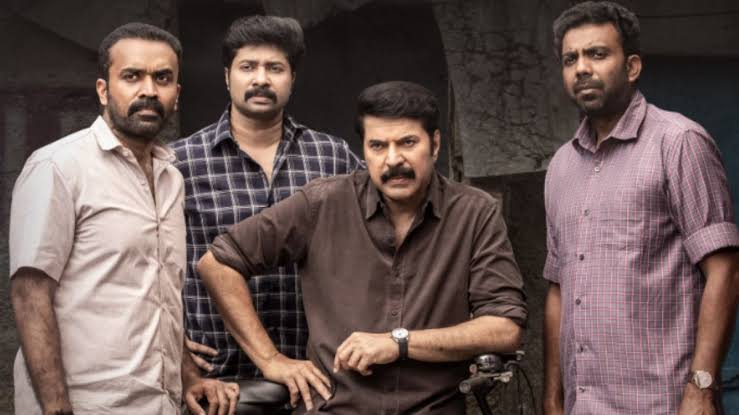
The story of men in uniform has been told in many different ways: Give them guns and ask them to shoot-at-sight, explore their immediate surroundings and the role they play in it, rip their Khakis off, dive deep into what made them wear it in the first place, and even mock them for their obedience towards higher-ups. Recently released Malayalam movie Kannur Squad does all of these with utmost dignity so much so that it falls into the trap of servility to authority.
The tone of the movie swings like a slow pendulum, loosely hanging on the great wall of Malayalam cinema– Mammootty, who plays ASI George Martin. The film keeps us guessing until the interval about what it aims to achieve before it loses the plot and plants itself in stereotypes.
The intent of the debut director, Roby Varghese Raj, is clear from the word go. He does not want to tell a story that has already been published, as told by a character played by Sunny Wayne later in the movie, perhaps alluding to the slew of police procedurals released in the recent past. Conflicts of multiple colours are painted on the canvas to beat the familiarity. The result is a kaleidoscope, where broken ideas try their best to make a complete picture.
Livelihoods at stake
All four members of Kannur Squad, despite their differences, have investigated and cracked cases together. They lack the glamorous lifestyle of higher rank officers and are dedicated to their job irrespective of their skillset.
Through the character of Rony David, the director traces the root cause of corruption and the public’s hyperfixation on it. A cyber cell officer says, “Why should we pass the bad news when they are stuck in a godforsaken village.” The subtle performances by Azees Nedumangad and Shabareesh Varma bring life to the other members, especially the main man. George’s biggest task, when not chasing criminals, is to handle pressure from above and fight his inner demons to be a good leader for his subordinates. The different shades of dilemma are carried gracefully by Mammootty. In a scene where his decision-making skill in Coimbatore is questioned, George justifies going by the book saying he is a policeman.
The question of moral values is tossed in the air, but it lands safely in favour of the squad when the screenplay takes the route of a road trip with a song dedicated to the motto of Kerala police ‘Mridhu Bhave Dhrida Kruthye’ (Soft in temperament, yet firm in action). The essence of another scene, that recycles the ‘Good Cop, Bad Cop’ interrogation technique to expose the hypocrisy of those wielding power, also gets lost by the time credits roll.
The idea is novel: Yes, all humans are oppressed in some way or the other. But it takes the dangerous turn to examine the fragility of policemen in the name of law and order, a language often used by majoritarian governments, through pure cinematic moments. It deals the Good Cop, Bad Cop card back to the audience through Mammootty, who throws shade at the law and order situation in other states to make Kerala look better.
Cinematic value, but at what cost?
The film’s biggest deception was to use realism as a hook to satisfy an audience that accepts slow narration, but has an insatiable thirst for mass masala films. Malayalam movie RDX became a sleeper hit at the box office in a similar way: Taking the side of a powerful family against the residents of a colony. Kannur Squad places its politics between copaganda, a form of propaganda where police are depicted in a positive manner while hiding their negative qualities; and enforcing a stereotype that crime flows in the blood of marginalised communities.
The film also tries to emphasise the sanctity of the vehicles used by policemen. Tata Sumo, used in the movie, acts as an extension of the squad. This anthropomorphism breaks the initial idea of portraying struggles of policemen, and persuades the audience to develop empathy towards the system.
One of the scenes in Kannur Squad testifies the currency of writer Arundathi Roy’s scathing critique on Shekhar Kapur’s Bandit Queen. The essay, titled ‘The Great Indian Rape Trick’, says “If it weren’t the ‘Truth’, what would redeem it from being just a classy version of your run-of-the-mill Rape n’ Retribution theme that our film industry churns out every now and then?” The scene where a character (probably minor) gets sexually assaulted has no connection to the crux of the story. Yet, it is used as a plot device to deepen the stakes and show the brutality of the villain, as we see in the climax. Soon after meeting the girl, an angry George decides to start the hunt for the suspect right away, luckily, without the typical loudness we usually see in such situations. To satisfy an audience, when will filmmakers stop taking the easy route using the modesty of a woman?
It is hard not to notice the film’s technicalities and the effort that went behind it. For 91 days, 2,180 people toiled day and night with the crew covering nearly 12 cities. While DOP Muhammed Rahil blends a fly-on-the-wall approach with all visual elements needed for a mass commercial cinema, editor Praveen Prabhakar adds a disjointed charm to a linear story on paper. Sushin Shyam scores big in tense moments but fails the consistency test.
Kannur Squad is a nod to the newer age Malayalam cinema that has realised appropriating progressive values to tell a conservative story can help them get accolades, and make money at the box office.



